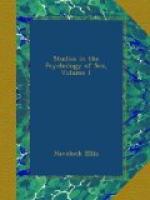It has been urged by some that the fact that the sexual orgasm usually fails to remove the disorder in true hysteria excludes a sexual factor of hysteria. It is really, one may point out, an argument in favor of such an element as one of the factors of hysteria. If there were no initial lesion of the sexual emotions, if the natural healthy sexual channel still remained free for the passage of the emotional overflow, then we should expect that it would much oftener come into play in the removal of hysteria. In the more healthy, merely hysteroid condition, the psychic sexual organism is not injured, and still responds normally, removing the abnormal symptoms when allowed to do so. It is the confusion between this almost natural condition and the truly morbid condition, alone properly called hysteria, which led to the ancient opinion, inaugurated by Plato and Hippocrates, that hysteria may be cured by marriage.[288] The difference may be illustrated by the difference between a distended bladder which is still able to contract normally on its contents when at last an opportunity of doing so is afforded and the bladder in which distension has been so prolonged that nervous control had been lost and spontaneous expulsion has become impossible. The first condition corresponds to the constitution, which, while simulating the hysterical condition, is healthy enough to react normally in spite of psychic lesions; the second corresponds to a state in which, owing to the prolonged stress of psychic traumatism,—sexual or not,—a definite condition of hysteria has arisen. The one state is healthy, though abnormal; the other is one of pronounced morbidity.
The condition of true hysteria is thus linked on to almost healthy states, and especially to a condition which may be described as one of sex-hunger. Such a suggestion may help us to see these puzzling phenomena in their true nature and perspective.
At this point I may refer to the interesting parallel, and probable real relationship, between hysteria and chlorosis. As Luzet has said, hysteria and chlorosis are sisters. We have seen that there is some ground for regarding hysteria as an exaggerated form of a normal process which is really an auto-erotic phenomenon. There is some ground, also, for regarding chlorosis




